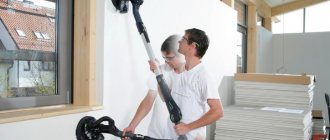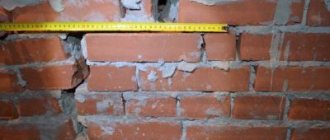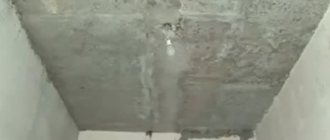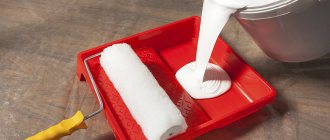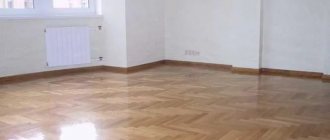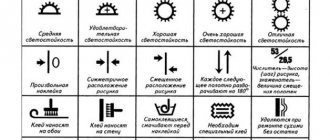Tell me, is peeling plaster a reason to panic or not? For non-professionals, this situation can become stressful. Professionals will say that inconsistencies can be corrected. Moreover, even an amateur can eliminate plaster defects. And beginners will find useful information on how to avoid problems and give the building a respectable appearance.
Failure to comply and/or violation of technical standards and ignoring the recommendations of dry mix manufacturers can lead to defects in the plaster. When carrying out preparatory work for plastering, as well as when preparing mixtures, applying layers to the base, improper operation and when the structure settles, defects may appear on the treated wall. We will talk about them in detail in the article. For complete clarity, let's divide the problems into two categories:
- Technological defects.
- Problems arising as a result of operation.
Plaster defects and their correction
You need to know about the causes of their appearance and how to eliminate plaster defects and be able to correct damaged areas. When it is necessary to replace the plaster, it is important to check its strength. After which a decision is made to replace the plastered surface. There are several ways to inspect the problem area:
The easiest way to identify defects in plaster is to use a spatula or scraper. The tool is passed along the surface of the wall. In places where cement chips begin to crumble, cosmetic repairs should be made.
To identify and eliminate defects in the applied layer, you can use a hammer as a tool. Tap the surface with the wooden handle of the tool. Where a dull response appears, replace the unreliable surface. If there are many problem areas, experts recommend completely replacing the plaster on the entire wall.
If there are damp spots on the wall that are characterized by a different dark color tone, the problem area should be replastered.
Important!
It is necessary to replace not only the damp piece, but also to replaster the area within a radius of 500-700 mm from the damp center.
You can check the quality of the layer with a knife, lightly pressing the surface and running the blade along it. If there are cracks, they will either fall off or sink inward. The problem area needs to be expanded and cosmetic repairs carried out.
Expert advice
Experts in the field of decorative plaster repair advise adhering to the following tips:
- If repairs are made using a cement-sand mixture, then the rule must be followed: the thicker the layer required, the larger the sand grains contained in the mixture.
- To prevent the prepared mixture from drying out prematurely, it is kneaded in small portions. For thin layers, you can use a liquid solution. To make it more dense, you can make the composition thicker.
- Peeling occurs when plastering a very dry surface. To eliminate this defect, it is necessary to dismantle the plaster on the damaged area and reapply it.
In rooms with high humidity it is better to use cement plaster, and for wooden surfaces use limestone material.
- To repair old plaster, you need to clean the seams by 5–10 mm, sweep away dust and dirt from them. Then they are thoroughly cleaned with a metal brush and treated with warm water so that the new layer of plaster adheres tightly to the old one.
Decorative plaster is easy to repair. To complete it, you need to calculate the amount of material required and take the correct measurements. The solution must be mixed in strict proportions to obtain a quickly hardening mixture.
Plaster inspection
Quality requirements are specified in SNiP 3.04.01-87 “Insulating and finishing coatings”. You can identify and identify flaws using a linear laser level. The laser line is projected onto the wall where the laser plane should appear. In this way, the vertical deviation of the surface and the horizontal deviation of the surface can be checked. Today there are two known methods for assessing the evenness of a wall:
- On a large area.
- On a small area.
Technology for repairing the facade of a building with painting and preparation
Technical recommendations on the technology of painting interiors and facades of residential and public buildings under construction Date of introduction 2003-10-01
DEVELOPED BY SUE "NIIMosstroy"
APPROVED by the Head of the Department of Scientific and Technical Policy in the Construction Industry A.N. Dmitriev on August 18, 2003.
INSTEAD VSN 45-96
These recommendations have been developed to replace VSN 45-96 “Instructions for the technology of painting interiors and facades of residential and public buildings under construction and reconstruction.” The recommendations outline the technical characteristics of a wide range of currently used paints and varnishes and coating systems, the use of which increases the decorative effect and service life of protective coatings, presents the technology for the production of finishing works when painting and finishing the surfaces of building structures with textured compositions, and provides a map of step-by-step control quality.
State Unitary Enterprise "NIIMosstroy" (OS "Mosstroysertifikatsiya") and State Institution (OS "ENLAKOMsertifikatsiya") have formed a database on the certification of paintwork materials and paintwork systems, as well as a database of expert opinions on the quality of finishing materials produced by domestic and foreign manufacturers for the period 1997-2002 .G. The technical requirements for coating materials are based on the analysis of this information.
Technical recommendations are intended for engineering and technical workers and foremen of construction organizations carrying out interior and exterior finishing work, as well as designers and organizations carrying out quality control of work.
Recommendations were developed by the State Unitary Enterprise "NIIMosstroy" (Ustyugov V.A., Kalinin Yu.A., Voropaeva R.I., Yastrebova Z.A.) with the examination of the State Institution (Usatova T.A.)
Types of plaster defects
As we noted earlier, there are two types of defects.
- Technological defects.
- Operational defects.
The first ones appear when recommendations and building codes are violated. The most common defect of technology violation is the appearance of small growths (tubercles) on the treated wall, which are characterized by the presence of white spots in the middle - these are dummies. We will talk about them and how to combat them below. Let us only note that the dummies appear during the preparation of a solution of uncured lime.
The second includes cracks in the plaster and peeling. They can form over time as a result of wear and tear. To prevent the plaster from falling off, you need to regularly carry out preventive inspections and, if necessary, make cosmetic repairs. Experts recommend carrying out work when renovating the entire apartment.
So, let's take a closer look at each problem and define the “technical treatment of walls.”
Dutiki
To remove tubercles on the surface of the plaster, it is necessary to completely clean their locations using an iron spatula. Then apply the solution to the treated surface.
Cracks in plaster
The reasons for the formation of cracks in plaster can be different. This defect is the most common and is the result of errors in surface preparation. Perhaps the components of the working solution were not mixed thoroughly enough. Their appearance can be facilitated by an excessively thick layer of applied mortar if it was applied to a non-reinforced wall. This phenomenon can only be avoided by carefully mixing the gradients of the future solution.
Swelling and peeling of plaster
The defect is not that common, but it does happen. Perhaps, when plastering damp surfaces, the technology was violated: there was not enough time for the layer to dry. A defect may occur if the base is very wet. Lime-gypsum and lime plasters suffer from this “disease”.
Cracks in the husks
They arise as a result of poorly prepared joints of different components: wood and concrete, plaster and brick. Small cracks can be eliminated by grinding, which will be discussed below.
Large cracks must be “cut off”: cleaned with a steel brush while generously wetting the problem area with water. And only after that apply a new layer of solution.
The shingles are replaced with new compositions after treating the defective areas: you will have to cut out the low-quality layer.
Efflorescence
Efflorescence, or efflorescence as they are also called, appears as a result of high room humidity. This is a signal of insufficient ventilation; you need to pay attention to this, otherwise over time you may encounter fungus and mold on the wall.
It is possible to fight this phenomenon. It is necessary to try to dissolve the deposits in water. In the fight you need to use special means that are always available in the retail chain. The work uses metal scrapers, brushes and rollers.
And further
To protect the facade of the building, it is necessary to perform hydrophobization. This is the application of a special solution to the wall.
Important!
The mixture must have frost-resistant, water-repellent and airtight characteristics.
Complex measures need to be carried out when water often impacts the wall.
This is especially true for areas with high precipitation rates. Walls treated with water repellents have a service life of 10 years or more. To protect bricks, water emulsions, water-soluble mixtures or solvent-soluble components are used.
Based on the appearance of the cracks, we will try to determine the cause of their occurrence.
1. Cobwebby.
Fine surface cracks 1 mm deep (maximum 2 mm).
Possible reasons:
- The solution is rubbed in too hard.
- Insufficient reinforcement
- The plaster was applied in too thick layers
- Too much water in solution
- Dries too quickly
2. Cracks coming from the base of the plasters.
Cracks run through the entire plaster layer.
Possible reasons:
- Poor quality plaster material
- Excessive use of various additives
- Violation of application technology, basting.
- Incompatibility of individual layers of plaster.
- Dries too quickly
- Many washable components (sand)
3. Cracks at seams and joints.
Through cracks passing through the entire thickness of the plaster to the masonry seams.
Possible reasons:
- Poor quality plaster material
- Excessive use of various additives
- Violation of application technology, basting.
- Incompatibility of individual layers of plaster.
- Dries too quickly
- Many washable components (sand)
4. Structural cracks.
Straight or geometrically directed cracks with a large opening.
Possible reasons:
- Movements of structures and foundations
- Changing the shape of the structure;
- Displacement of structures due to loads
5. Structural cracks originating from the foundation.
Possible reasons:
- Soil mobility
- Uneven settlement of the building
- Vibration loads from the proximity of transport or construction
How to restore the integrity of plaster
Grinding the old layer will extend its shelf life. It is necessary to perform this technical action regularly. It can be combined with changing wallpaper, for example, or with complete plastering of the walls. The process involves grouting the old layer with the preliminary removal of old paint or wallpaper. The new plaster mortar is prepared using cement and sand with small fractions.
Finally
Knowing about the problems, you can effectively deal with them. But repairs should not be taken to extremes or delayed. It is important to regularly inspect the condition of the plaster and respond promptly, remember this.
How to find out if a material needs repair work?
By characteristic signs you can determine whether the plaster needs repair. Among them are the following:
- Color change . Faded stains of greasy composition are visible. Rust stains appear, and sometimes soot appears.
- Serifs and protruding fragments appear . The wall does not crumble, but it bulges greatly and its appearance is lost.
- Fragments of plaster begin to peel off from the wall . The walls are crumbling, the floor has to be washed or vacuumed every day.
The appearance of the plastered wall changes greatly; flaws and faded areas become clearly visible. If defects cannot be immediately noticed even visually, then a simple tape measure and a bar with a level can come to the rescue. These tools are used to inspect surfaces. Any deviations in level lead to conclusions about an incorrect or outdated external façade.
If misfires and defects are detected, you should think about whether the surface needs to be radically repaired. Simple calculations will allow you to do without complex manipulations if the defects are minor. For example, if the plaster is peeling off in one place, you can stick embossed wallpaper . This simple solution saves time.
You can level the old layer, but most often you will have to tear off the surface layer and apply a finishing base. You can do this yourself. You just need to select the materials and mix them well together.
What to do?
If the cement-based plaster has come off from the aerated concrete, then you need to completely clean it off and reapply it.
First, it is advised to finish the walls inside the room, and only then finish the facade.
The plaster may come off due to constant changes in humidity. You need to find the source of the increase or decrease in humidity and correct it.
If this happened due to a mixture of poor quality or an old composition, then you can only completely remove the old finish and apply a new one.
The problem should be carefully studied; perhaps this was due to subsidence, which appeared due to the fact that the plaster preparation time specified by the manufacturer was not followed. Then just redo everything.
When applying the mixture in hot weather, it is necessary to slow down the drying of the walls. To do this, they are moistened from time to time.
But if cracks do occur, then the walls are rubbed with mortar or gypsum dough. If the gaps are too large, they are widened, cleaned, moistened and plaster is applied.
Try placing paper tape over the peeling plaster area. If the tape breaks, you will have to start all over again.
Sealing cracks in plaster has its own algorithm of actions, filled with some subtleties that require careful study.
Subtleties of sealing cracks:
- It is advised to buy a mixture of the same brand that was used previously.
- You cannot work at air temperatures below +5°C and at humidity levels above 80%.
Repair of the base reinforcing layer
If the mesh is damaged, sections of the base are beaten off at a distance of 30–40 cm on both sides of the crack. In this case, the smallest and weakest fragments of the coating finally peel off. At this stage, it is important to check how reliable the adhesion of the surviving areas of finishing to the base is. Areas unaffected by damage can be left, sanding the edges to reduce them to nothing in a strip of about 15-20 cm.
Restoring the façade involves fragmentary or complete re-application of the base. Moreover, the new mesh must be laid with an overlap of 20–30 cm in areas where the old one remains. Such patches are made using the basic technology for applying facade plaster: first, the entire open surface of the insulation and adjacent areas of the preserved base are wiped with the mixture, then a mesh is applied and smoothed, and finally a thin leveling layer is applied. After repairs, the wall should be allowed to dry and reinforced with additional disc dowels if necessary. Afterwards, the entire surface is primed and sealed with another layer of base, usually with additional reinforcement.
If there is no damage to the mesh, repairing the base is incomparably easier. The edges of the cracks must be carefully cleaned with an abrasive float and primed well. It is important that the sealing is carried out with a compound of the same type as the base. After repairing cracks, the entire surface of the base is primed until absorption stops and covered with one general leveling layer about 3 mm thick.
Wall alignment errors
The most common alignment mistakes are:
- applying too thick a layer;
- lack of reinforcement;
- violation of solution preparation technology;
- fractures of the wall plane;
- crooked corners.
In case of plane fractures, the finishing is removed, the beacons are re-installed and plastered. Crooked corners are corrected by removing (knocking down) excess and building up (applying additional solution) insufficient coverage. If peeling and cracks appear due to missing reinforcement or a thick layer, the coating is also removed and the wall is plastered again.
Eliminating existing defects in the applied plaster coating does not mean eliminating the possibility of their reappearance. It is necessary to neutralize the cause of their formation. Features of technologies for preparing mortar and plastering with various compositions of walls made of dissimilar materials are given in the sections “Types of plaster” and “Plastering”.
How is the need for major façade repairs determined?
Its participants are:
- government contractor;
- authorized employee of the management organization (authority);
- active members from among the owners appointed at the general meeting.
After checking and analyzing all the damage, the commission decides whether major repairs are needed or whether it is permissible to limit ourselves to only superficial restoration. This decision is not based only on one’s own convictions, but must comply with regulatory documents.
Major repairs of an apartment building are carried out with the permission of the commission
So, major repairs are carried out if:
- the insulation is worn out or the seams between the slabs are broken, which affects the penetration of moisture onto the load-bearing wall;
- 35% of the external walls contain destruction of the external cladding;
- The drainage system is broken.
Based on the results of the inspection of the external walls, the commission brings up for discussion what capital work needs to be carried out depending on the nature and extent of the damage.
How to prevent cracks and holes from appearing?
To prevent the appearance of cracks, cracks and holes in the plaster, you must follow the rules for its application.
Any house shrinks, on any soil. It is not recommended to plaster walls for at least 1 year after building a house. This can be done during the construction of a private country house, but in commercial construction this approach is not encouraged.
- Firstly, you need to try by any means to insure the walls from the appearance of cracks. Proper preparation of the base will help. They need to be cleaned of dust and moistened with a glue solution. Small fractions of sand and concrete will be securely glued to the wall and will not create air pockets in the future.
- Secondly, it is advisable to use reinforcing mesh. It is available in different thicknesses, so you can choose it for even the thinnest basting.
- Thirdly, the mixture for plastering the base must be prepared according to technology (how to dilute the mixture correctly?). A small amount of cement will weaken the plaster, and excess will destroy the crystal lattice of the coating.
- Fourthly, the drying regime must be maintained in accordance with the brand of cement. The room temperature should be from 5 to 20 degrees, drafts are unacceptable.
- Fifthly, when plastering the ceiling, it is advisable to use a quick-drying mixture or add alabaster or gypsum to it yourself.
Will surface strengthening help?
You can often come across the opinion that in order to restore the appearance of the facade, it is simply enough to cover it again with a decorative composition, but this is only a temporary solution. Due to the formation of an air gap between the deeper layers, such actions will only aggravate the situation; moreover, it is impossible to predict in advance how increasing the thickness of the protective and decorative layer will affect the vapor permeability of the wall as a whole.
Even if a new base is applied over the facade and attempts are made to save on dismantling the coating, the repair will not give the expected result. Yes, a new strong crust is formed on top of the coating, which quite possibly can withstand the total weight of the finish and the tearing force for some time. However, all external finishing layers must comply with the rule of increasing hygroscopicity from internal to external, which is absolutely impossible when performing double plastering. It must be remembered that only the aesthetic lifespan of plaster facades is at least 10 years, after which the building is simply painted again. The mechanical durability of a “wet” facade is at least 30 years, so a consistent and thoughtful approach to the problem of destruction of the finish, as a rule, turns out to be more economically feasible than taking temporary measures.
rmnt.ru
